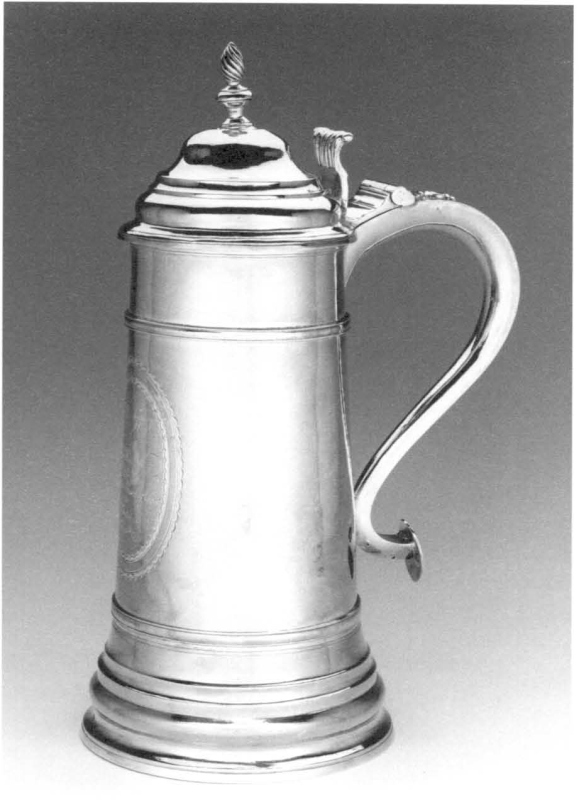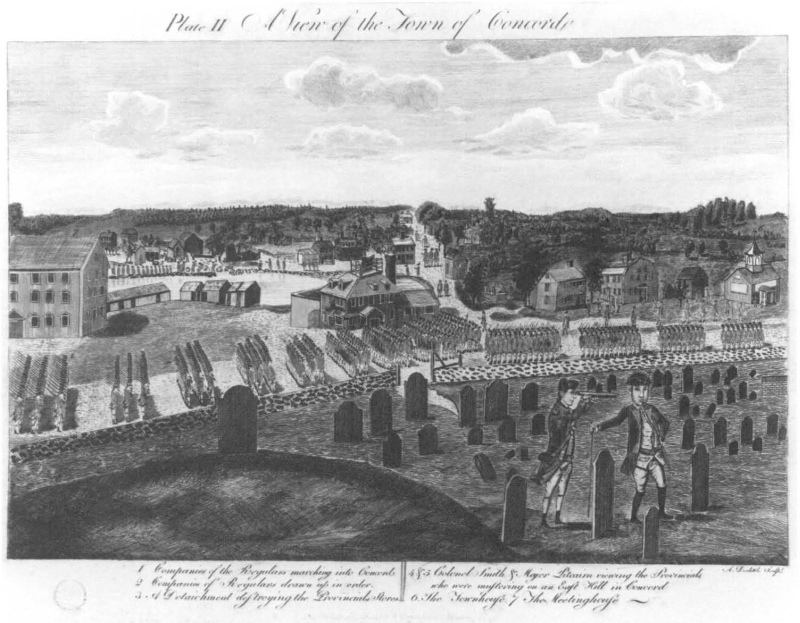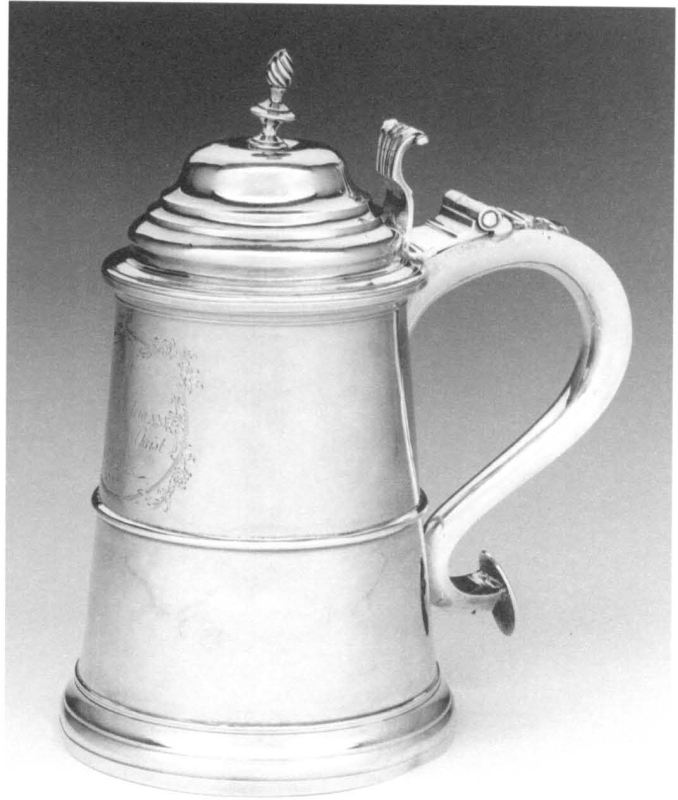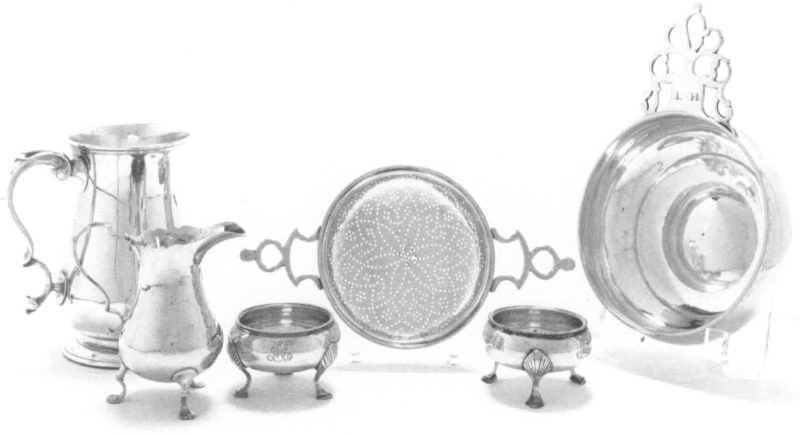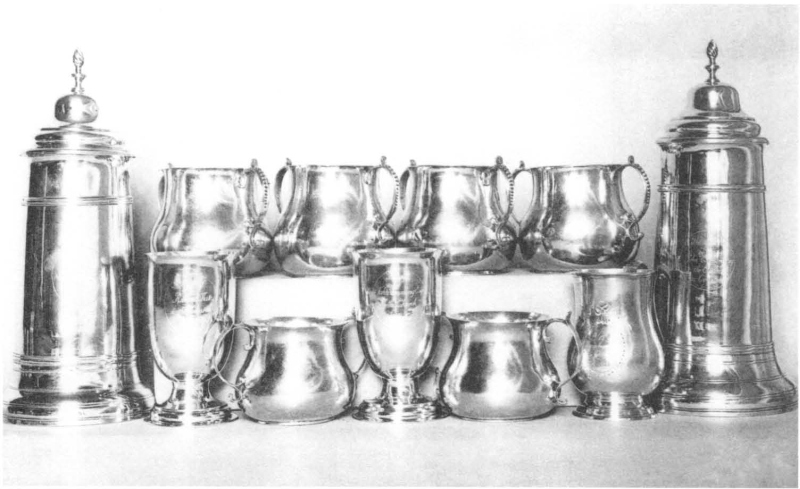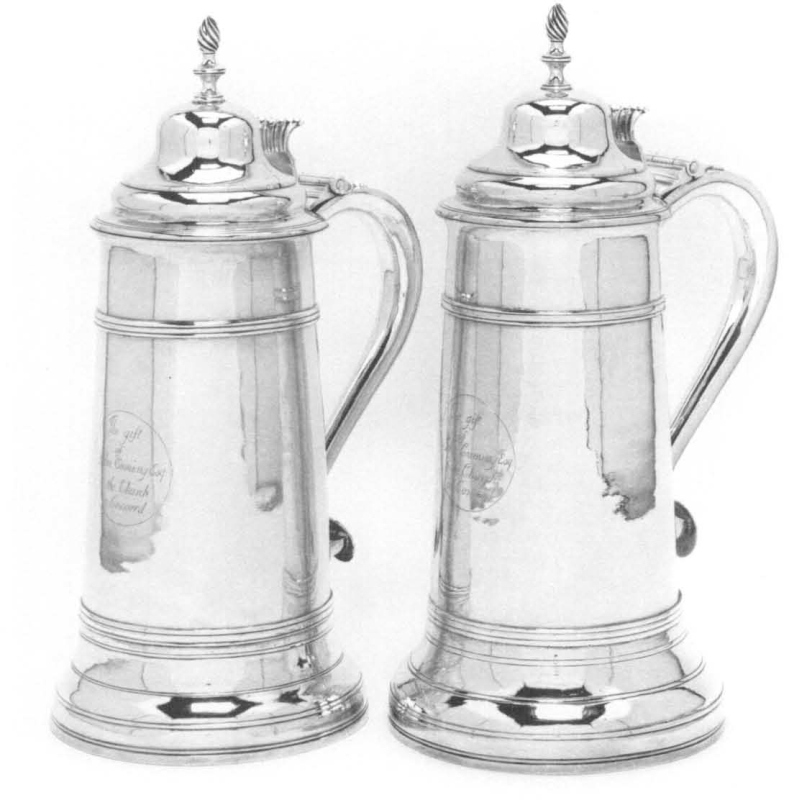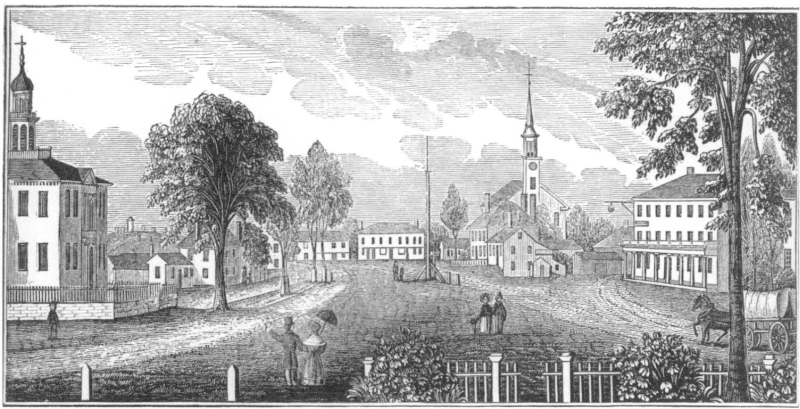“An influential and useful man”: Samuel Bartlett of Concord, Massachusetts
David F. Wood
The phrase historian Lemuel Shattuck used to describe silversmith Samuel Bartlett (1752–1821)—“he was an influential and useful man”—would not apply to one who was a craftsman solely.1 In addition to being a silversmith, Samuel Bartlett was a good citizen; in addition to being a clerk, he was literate, professional, and provident. Born in the largest city in colonial New England, Bartlett grew up in a period of contracting economic opportunity and political change.2 A youth in occupied Boston, he came of age in Revolutionary Massachusetts, provided for a large family during a period of constitutional crisis, and abandoned his craft in the same period that saw the beginning of New England’s industrial revolution. The record of Bartlett’s life includes examples of some of the new challenges and opportunities that were changing the nature of craft, civil service, and citizenship in this region in the Revolutionary era.3
Samuel Bartlett was born, probably in Boston, in 1752. He was the son of Roger Bartlett of Branscombe, England, and of Anna Hurd of Charlestown, Massachusetts, who married in 1749. Roger Bartlett was a mariner, a captain of merchant ships engaged in the Bristol-to-Boston trade; Anna Hurd was the daughter of Benjamin and Elizabeth Hurd.4 Samuel grew up in Boston’s industrial North End, where he attended Christ Church on North Street. The only son in the family, Bartlett initially wanted to be a mariner like his father. His mother, however, persuaded him to become “a pupil of the famous master Tileston”5—an education that would provide him with the skills for a career in commerce or to augment the training of a craft trade. Silversmithing, apparently, had not yet emerged as his profession of choice.
John Tileston, “one of the noted school-masters of the past, ‘the father of good writing in Boston,’”6 devoted seventy years to teaching at the North Writing School, where he had started as an apprentice at the age of fourteen. The school, located on Bennett Street, taught the practical aspects of reading, arithmetic, and writing mostly to students anticipating careers in business, rather than the classical education that grammar schools provided as preparation for college—that is, Harvard. The North Writing School was one of three public writing schools in Boston, all of which admitted students as young as seven. The only public school in the North End, Tileston’s was particularly large, with as many as 150 students present at times in the 1760s. Tileston’s journal records the purchase of slates by the dozen, paper by the ream, and quills by the thousand. His students included sons of the North End’s many craftsmen and tradesmen, and some boys did serve craft apprenticeships while attending classes. Among them were the carver Simeon Skillin, Jr., whose father and brothers were also carvers; Gawen Brown, Jr., the son of a London-trained clockmaker; silversmith Henry Loring, the son of silversmith Joseph Loring; and Paul Revere III, the son of the Patriot and a third-generation silversmith.7
The celebrated orator Edward Everett, perhaps best known for delivering a two-hour address at Gettysburg that was upstaged by Lincoln’s two minutes, went on to college after attending the Writing School. Recollecting his early education some years later, Everett provided a colorful picture of life at the school:
Master Tileston was advanced in years, and had found a qualification for his calling as a writing-master in what might have seemed, at first, to threaten to be an obstruction. The fingers of his right hand had been contracted and stiffened in early life by a burn, but were fixed in just the position to hold a pen and a penknife, and nothing else. As they were also considerably indurated, they served as a convenient instrument of discipline. A copy badly written, or a blotted page, was sometimes visited with an infliction which would have done no discredit to the beak of a bald eagle.
Everett went on to say: “I desire, however to speak of him with gratitude; for he put me on the track of an acquisition which has been extremely useful to me in after life—that of a plain, legible hand.”8 An account book kept by brass-founder and coppersmith John Andrews, who also appears in Tileston’s lists of students, exemplifies that hand.9
Although Samuel would have found himself among a number of future artisans in this environment, he probably did not undertake his education at Tileston’s school with that goal in mind. Rather, according to his biographer, Concord physician Josiah Bartlett (no relation), circumstances forced Samuel to abandon his studies in order to pursue a trade.10 The biographer records that Samuel was partially deafened at the Boston Massacre on March 5, 1770—the only hint of any political activity on Samuel’s part.11 That handicap, together with the “disturbed state of the country,” turned the young man toward his future as a silversmith. Josiah Bartlett could be in error over this event: eighteen is a late age to initiate a craft apprenticeship, which typically began at age fourteen and lasted about eight years.12 If Samuel’s training in fact followed this more traditional path, he could have started his apprenticeship with Samuel Minott, a leading Boston silversmith, during his schooling: apprenticeships often provided for schooling as well as clothing and housing.
Samuel Minott ran his shop in Boston for at least forty years and, according to Patricia E. Kane, ranked with Paul Revere, Jr., and Benjamin Burt as “one of the principal retailers of silver in Boston in the late colonial period.”13 Samuel Bartlett, however, is the only apprentice known to have received his training at Minott’s shop—an anomoly for a shop so active for so long; evidence suggests that Benjamin Burt’s shop trained at least eight young men.14 Of course, Minott probably did train others, including possibly Joseph Lasinby Brown (1753–1804), who later became a business colleague of Bartlett’s. The only son of Boston housewright Ebenezer Brown and Elizabeth Lasinby, whose family were shipwrights, Joseph was also a native of the North End. Like Bartlett, he attended Christ Church and Tileston’s school. Referred to as a goldsmith or jeweller in legal documents, Brown seems to have carried on this trade in the North End from the late 1770s until 1785.15
The dearth of known apprentices from Minott’s shop may also reflect the particular spin that Minott put on his business: he favored a high retail volume and may have kept production at a relatively low level. He focused instead on selling merchandise, domestic and imported, produced elsewhere. According to an advertisement placed in Boston in 1772, Minott’s goldsmith shop remained a shop separate from his retail shop, in which he sold various goods, including teas, spices, and groceries; creamware, delft, and stoneware; and silver, coral beads, and jewelry.16 He also bought silver from Paul Revere’s shop, and his mark occurs together with those of six other silversmiths who were providing him goods for resale.17 In the shop Bartlett later set up in Concord, he made use of many of these same marketing strategies.
By 1775, as the war for American independence began, Samuel Bartlett had achieved his professional and personal independence. Josiah Bartlett and Lemuel Shattuck, however, disagree about the exact time at which the young man became autonomous. Bartlett wrote that “before he got through his time [apprenticeship], the war of the Revolution began.” Shattuck believed that Bartlett removed to Concord in 1775, “soon after commencing business.”18 Both nonetheless recognized the beginning of the Revolution as the cause of Bartlett’s next change of circumstance, and it seems certain that Bartlett had attained his majority—that is, aimed twenty-one—in 1773, the year of the Boston Tea Party. When the war began, catching his father at sea, Samuel first relocated to Woburn, about ten miles from Boston, with his mother and his two sisters and their families. He married Polly Barrett, the daughter of Boston merchant Isaiah Barrett, in September 1776. Soon after, the newlyweds moved to Concord.
Bartlett may have moved to Concord simply because it was one of the towns that provided refuge for people fleeing Boston. In addition to the faculty and students of Harvard College, who removed there for the duration of the siege, some eighty of Boston and Charlestown’s poor escaped to Concord at the beginning of the war.19 Among the other tradesmen who chose Concord at around the same time were Emerson Cogswell (1744–1808), who established himself as a hatter on the Mill Dam, and Bartlett’s fellow silversmith Joseph Lasinby Brown; all three men would eventually work themselves into the fabric of the town’s social and economic life.20
Bartlett’s reasons for leaving besieged Boston are easy to imagine, but any professional appeal Concord would have held is harder to see.21 Silversmith John Ball had been working in Concord for ten years without conspicuous success; his silver is rare and he seems to have had to recapitalize periodically by mortgaging inherited land.22 Concord probate records from the end of the eighteenth century, reflecting midcentury households, portray a limited market for silver. The inventories note silver teaspoons and buckles but little else. Tankards are rare, only five or six recorded, and predictably occur in households with the other reliable markers of wealth, eight-day clocks and looking glasses. The most extensive assemblage of silver in eighteenth-century Concord belonged to physician and moneylender Abel Prescott. Prescott owned three tankards, six canns, a large pair and a small pair of porringers, a small porringer, a sugar box, a creampot, pepper caster and sugar tongs, two sets of pepper casters, a silver teapot, and seven large spoons and twelve small. He also owned three pairs of gold sleeve buttons made by John Ball—the one instance of local patronage documented in his inventory.23
Bartlett accommodated himself to Concord’s limited market, choosing not to set up immediately as a silversmith. “On coming to Concord,” Josiah Bartlett wrote, “Mr. Bartlett opened a small store, vending the usual merchandise of a country trader.”24 He may have modeled his operation on Minott’s retail shop in Boston, with its sundry goods and mix of silver by various smiths.25 At the same time he commenced trade, Bartlett began to integrate himself into the civic life of the town. As early as 1777, for example, Bartlett, along with Cogswell, participated in the founding of a remarkable institution that continues to the present, the Social Circle; Joseph Brown joined them in 1785. An unofficial parliament of twenty-five townsmen, the Social Circle met on Tuesdays during the winter to discuss town or other matters, including many suggestions for town improvements and celebrations that later won adoption.26
Bartlett completed four public commissions during his career, all for communion silver. The first two were filled prior to his acquiring a shop separate from his house, and the first commission may in fact have preceded his move to Concord altogether. All four commissions resulted from bequests, the two earliest made during the Revolutionary War. In the second instance, the work was not paid for until the 1780s; this piece is nevertheless the earliest securely dated piece of Bartlett’s silver. In the first case, it is not clear when Bartlett did the work as no record of payment survives and the evidence of the silver itself is somewhat equivocal.
The first of the early commissions originated in the will of Deacon Thomas Waite of the First Church, Boston. When proved on May 19, 1775, a month after the North Bridge fight, the will revealed a bequest for church silver: “I give to the First Church of Christ in Boston a Silver Flaggon for the use of the Communion Table equal in value and size to that given to the said Church by the Honl William Dummer.”27 The flagon made with Wake’s bequest carries Samuel Bartlett’s full surname mark (“S·BARTLETT”), but it has not proved possible to date it with precision. If it was indeed made near the date of the bequest, this flagon would be among Bartlett’s earliest independent work; historical circumstance, however, would argue for a later date (fig. 1).28
Most likely, since the conditions of war hardly favored the production of fine metal objects, the First Church deacons waited for the end of hostilities to fulfill Waite’s instructions. The occupation and closing of Boston’s port, the beginning of the Revolutionary War on April 19, and the subsequent siege of the city affected every aspect of Boston life. Shattuck estimated that the city’s population dropped from over 15,000 to under 3,000 as a result of a massive exodus.29 Consequently, Boston silversmiths turned out very little church silver in 1775. Some of the manufacturers, such as Revere, were otherwise engaged. At least one church put its silver, which represented a substantial portion of the church assets, into hiding; the First Parish in Charlestown removed the communion silver to Reading, Massachusetts, on April 22, 1775, three days after the North Bridge fight, and didn’t bring it back until 1783.30
An examination of the First Church flagon reveals a few details of manufacture that might be seen to support Josiah Bartlett’s suggestion that Samuel’s apprenticeship was interrupted by the Revolution. The products of Boston’s late colonial silversmiths are fairly consistent in conception and execution, and both are generally very competent. Bartlett’s flagon falls a little short on both counts. The bodies of eighteenth-century hollowware forms such as canns, tankards, and flagons were shaped by raising, the process of hammering a sheet of silver on a series of specialized anvils (stakes) held in a vise. The hammering both shapes and stretches the silver. As part of the process, the metal has to be periodically annealed—that is, heated red hot and quenched in liquid, which makes the metal ductile and readily worked. The hammering rearranges the crystalline structure of the alloy and makes the metal hard; if worked too long after annealing, the metal will crack. Some stress cracks present in the bottom of the Waite flagon are the result of the metal being worked too long after annealing, suggesting an inexperienced craftsman. In addition, the base on a hollowware form is often cast and the casting finished by turning on a lathe. The marks of this process are usually visible on the underside. The base of the Waite flagon, however, was raised from a sheet, then finished with files and soldered to the body, an unusual working method for Boston-area craftsmen. As a result, the base seems hesitant and fussy in composition, compared to the usually sure handling evident in Boston silver.
Fig. 1. Samuel Bartlett (1752–1821), flagon, probably Concord, Massachusetts, about 1775–95. Silver, h. 143⁄16 in. First and Second Church, Boston, on loan to the Museum of Fine Arts, Boston. Photo, courtesy Museum Fine Arts, Boston.
Contrary to these details of execution, which suggest an early date, is the engraving on the flagon, which suggests a date a decade or even two after 1775. The inscription is in an oval surround composed of a double border of scalloping and bright cutting, all elements of neoclassical design. The effect of the border resembles the engraved surround on a 1786 tankard by Benjamin Butt.31 Although the engraving may have been added later, this detail together with the historical circumstances favor the argument that the First Church delayed executing Waite’s bequest until after the war ended.
Fig. 2. Sidney L. Smith, replica of Amos Doolittle’s “A View of the Town of Concord (1775),” Boston, Massachusetts, 1903. Hand-colored engraving on paper; h. approx. 15 in., w. approx. 20 in. Concord Museum (Pi403).
Since the war undoubtedly dampened Bartlett’s silversmithing prospects in Concord, he apparently waited until its conclusion to pursue his craft there.32 Although even the postwar local market was limited, Concord nevertheless offered an advantageous location because it was a half-shire town for Middlesex County. The minor courts met there regularly throughout the eighteenth century, bringing in as many as 500 people from all over the county twice a year. At this time Bartlett apparently lived in a house with a shop attached across the street from the Wright tavern, near the courthouse in the center of Concord (fig. 2). By the end of the war, in the mid-1780s, Bartlett had a good enough reputation to attract a commission from the First Church in Weston, a town in eastern Middlesex County. With this commission, Samuel Bartlett resumed silversmithing after his venture as a dry-goods merchant.
In his will, proved in 1777, Weston, Massachusetts, merchant Isaac Bigelow bequeathed “To the Church of Christ in Weston a silver Tankard, to be made the value of all the silver and gold in my possession, exclusive of the making unless my executors judge it more than necessary.”33 Unlike the piece for the First Church of Boston, with its surrounding ambiguity, the Weston tankard can be dated confidently to 1785, which makes it clear that the Revolution interfered with the execution of the bequest. The account for Bigelow’s estate records on September 14, 1785, the cost of the tankard: £20.6.7.34
Fig. 3. Samuel Bartlett (1752–1821), tankard, Concord, Massachusetts, 1775–95. Silver; h. 9⅛ in. Unitarian Church of First Parish, Weston, on loan to the Museum of Fine Arts, Boston. Photo, courtesy Museum of Fine Arts, Boston.
This tankard is typical of Boston work of the third quarter of the eighteenth century (fig. 3). It resembles in form a tankard made by Samuel Minott in 1765 now in the Museum of Fine Arts, Boston.35 The tapering body of the Weston tankard rests on a cast molded foot, and it has a reinforcing midband and a domed, hinged top with a cast urn-and-flame finial. The inscription is surrounded by a meandering floral swag that is still quite rococo in spirit, resembling, for instance, the flowers engraved on a pair of canns made by Revere in the 1760s.36 The marks of a cloth-covered stake on the inside of this tankard (evidence of the later removal of a substantial dent) obscure the original workmanship to a certain extent, but this tankard seems to be competently made in all aspects.
In 1788, three years after the Weston commission, Bartlett bought the old jail in Concord to use as a shop and home. Although Concord business never reached the dimension of the Boston trade, Bartlett nonetheless established himself with the local market and as a local citizen. He provided his neighbors with spoons and other small items of his own manufacture along with other dry goods, probably including Boston-made silver along with English buckles, while at the same time making small items for other Boston silversmiths to retail. Josiah Bartlett wrote that “here he plied his trade, and in many families are still shown the silver spoons of his manufacture.”37
The most numerous surviving form by Bartlett is indeed the spoon, particularly teaspoons displaying the “bright-cut” style of engraving favored by silversmiths for neoclassical forms (figs. 4, 5). His other domestic silver, now relatively rare, is also small scale. Among the forms with Bartlett’s mark are tablespoons, creampots, salts, porringers, canns, a strainer, plated shoe buckles, and a miniature teapot (some are illustrated in fig. 6).38 All compare in workmanship to the products of any of several contemporary Boston shops. Also, similar to the pattern seen in Minott’s work, a relatively large proportion of the surviving Bartlett silver pairs his mark with those of other makers. A strainer bears Minott’s mark along with Bartlett’s, and Bartlett’s mark occurs with Joseph Loring’s on a pair of porringers, a ladle, and a cann. In all such cases, the presence of two marks raises the question of authorship: Were these smiths warranting the quality of Bartlett’s silver for their customers or was he selling theirs? The porringers present a particularly interesting example, since they appear to have been Loring’s personal possessions; engraved with the initials of Joseph and Mary Loring, they probably descended in the Loring family. Had Loring both made and owned them, what would account for the presence of Bartlett’s mark? In this case it is logical to credit Bartlett with their manufacture.
Bartlett probably numbered among the silversmiths who provided Samuel Minott with finished goods for resale in his Boston shop, and perhaps he did the same for Loring as well. If Bartlett was providing Boston makers such as Minott with finished goods, the shoe buckles with his mark on them suggest trade in the opposite direction, since these items were likely English imports. Joseph Loring provided Zachariah Brigden with shoe buckles and chapes for buckles, almost certainly English imports, and may very well have supplied Bartlett with the same products.39
For the church silver commissions, which were large and relatively complicated, and perhaps for the smaller goods as well, Bartlett seems to have had the assistance of Joseph Brown. In 1785, the same year as the Weston tankard commission, Brown moved to Concord, where he lived and worked for the next ten years. He returned to Boston about the same time that Samuel Bartlett moved to Cambridge. Grindall Reynolds speculated in 1888, probably correctly, that Brown came to Concord to work with his erstwhile neighbor and schoolmate.40 No silver bearing Brown’s mark is known.
Fig. 4. Samuel Bartlett (1752–1821), tablespoon, Concord, Massachusetts, 1775–97. Silver; 1. 7¾ in. Concord Museum (SI).
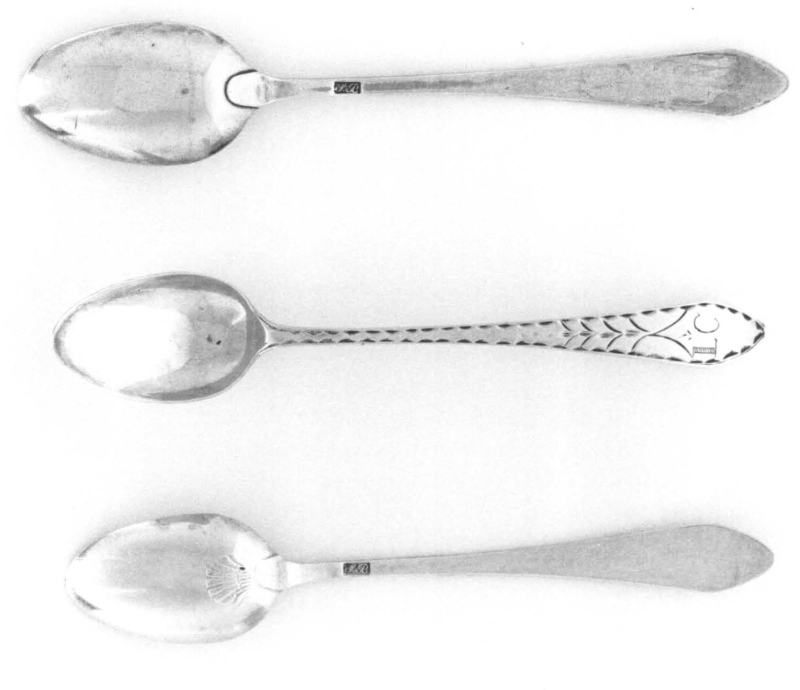
Fig. 5. Samuel Bartlett (1752–1821), three teaspoons, Concord, Massachusetts, 1775–97. Silver; 1. (middle spoon) 5 in. Concord Museum (S27; 1992.14–1, 2).
Fig. 6. Samuel Bartlett (1752–1821), cann, creampot, pair of salts, strainer, and porringer. Concord, Massachusetts, 1785–95. Silver; h. (cann) 5½ in. Concord Museum (1991.31; S150; 1990.28–29; S151; 1991–7).
Early in the last decade of the century, Bartlett had clearly established himself as an important Concord citizen and as a reliable tradesman. His largest silver commission and the largest grouping of his silver to survive in its original context dates from this period; it stems from the bequest made to the First Parish in Concord by Dr. John Cuming, who died in 1788 (fig. 7; see also figs. 8, 9). Cuming was a successful physician and veteran of both the French and Indian and Revolutionary Wars, and he served the town as a selectman. He also accumulated a considerable estate through inheritance, his work as a physician, money lending, and land speculation, particularly in the pasture lands of southern New Hampshire around Mason and New Ipswich. He had no children; his bequests included £25 for poor communicants in Concord as well as other money for the poor and a famous bequest to Harvard University that ultimately was used to found the medical school. “I give and bequeath,” reads his will, “to the Church in the town of Concord, Fifty Pounds Sterling, to be as soon as may be laid out in silver vessels to furnish the Communion Table.” The commission, probably executed in 1792, shows up in church records as a payment made early in 1793 for £66.13.4 to Samuel Bartlett, Esq., “Artificer.” In 1792 Bartlett also made five cups for the church in Groton, a Middlesex County town about twelve miles west of Concord. The cups for the Cuming bequest (fig. 8) are similar to a pair of the Groton cups and nearly identical to the other three.41
Fig. 7. Communion silver by Samuel Bartlett (1752–1821), ca. 1792, for the First Church, Concord. From E. Alfred Jones, The Old Silver of American Churches (Letchworth, Eng.: Arden Press for the National Society of the Colonial Dames of America, 1913), plate LII, no. 1. Photo, courtesy Museum of Fine Arts, Boston.
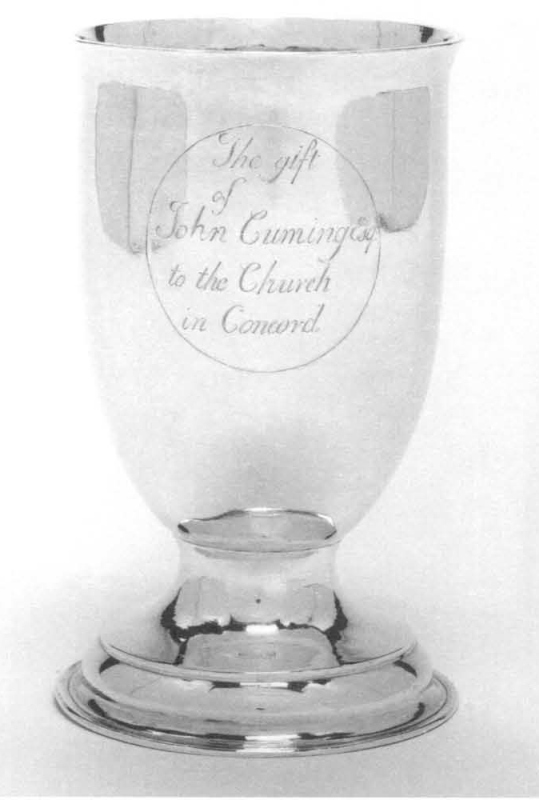
Fig. 8. Samuel Bartlett (1752–1821), cup, Concord, Massachusetts, ca. 1792. Silver; h. 6¼ in. First Parish Church, Concord, Massachusetts. Photo, courtesy Concord Museum.
Fig. 9. Samuel Bartlett (1752–1821), pair of flagons, Concord, Massachusetts, ca. 1792. Silver; h. (each) 15 in. First Parish Church, Concord. Photo, courtesy Concord Museum.
Formally, the flagons for the Cuming bequest are the most magnificent surviving Bartlett product (fig. 9). The workmanship is excellent and includes nice details such as high, domed tops and large, scrolled thumb grips. Prior to the Cuming bequest, the Concord church silver consisted of a suite of six caudle cups made by John Coney, two of them before 1690 and four of them in 1714. The silver Bartlett made represents something of a departure for the Concord church; for the first time since their gathering they were using ecclesiastical forms (flagons and footed cups) in their communion service.42
Samuel Bartlett’s careers as a citizen and as a silversmith converge somewhat on the First Parish silver. The decades following the end of the Revolutionary War were a time of significant change for the Congregational churches of New England, and Concord’s First Parish was no exception. Externally, the process of disestablishment from the state had begun, and internally Minister Ezra Ripley (who served in Concord’s pulpit from 1776 until his death in 1844) was struggling to keep his Concord congregation together.43 Beginning in the early 1790s, the First Parish changed the image of their meetinghouse, built in 1711. In 1791, the town appointed a committee, which included Samuel Bartlett, for “repairing and altering the Meeting house in said Concord.” Their recommendations included the addition of a steeple to the building (fig. 10).44
Fig. 10. John Warner Barber (1798–1885), Central Part of Concord, Massachusetts, 1839. Wood engraving on paper, h. 3¼ in., w. 6½ in. From Massachusetts Historical Collections (Worcester, Mass.: Dorr, Howland & Co., 1839), 378. Concord Museum.
There are many factors that may account for this apparent relaxation of the earlier, Puritan strictures against the palpably ecclesiastical forms, but it can be seen at least to be coincident with other changes within the church.45 The deacons of the church in 1792, who were responsible for awarding the John Cuming commission, were Joseph Chandler, George Minott, John White, and William Parkman. William Parkman was a tavernkeeper in the south part of Concord and later a storekeeper in the center of town. Minister Grindall Reynolds referred to Parkman in a biographical sketch as “an old Puritan.” Parkman disapproved of dancing, and as a justice of the peace, he was in the habit of trying and fining sabbath breakers for Sunday travel until one of his defendants had the law overturned on appeal.46 He remained a faithful member of Dr. Ripley’s flock. John White was involved in both decisions, the communion silver and the renovations of the church building. A merchant like William Parkman, John White was a dissident with regard to church matters. He led the faction that refused to accept Unitarianism and split off from the First Parish to form the Trinity Congregational Church in 1826, the great grief of Ezra Ripley’s long ministry.47
Samuel Bartlett had embarked on the second career that brought him into the heart of these matters—that of citizen—soon after coming to Concord. He first appears in the town records in relation to a 1781–82 school money apportionment, which may mean that he schooled some students that year. Subsequently, he began to hold the small offices required of all but the indigent. His first appointment to office came in 1785, when he was named one of the ten surveyors of highways and one of the two clerks of the market. Over the next ten years, Bartlett held seven town offices including sealer of weights and measures and clerk of the market, and he served on twelve town committees.48 Bartlett did not belong either to a Masonic lodge (Concord had no lodge until 1797) or to the militia, but he has received credit for reviving the Social Circle after internal dispute briefly ended its meetings. Given the composition of the Social Circle, drawn as it was from the merchants, artisans, and professional men in the center of town, membership must have provided contacts and opportunities.
In 1786, just one year after Bartlett’s first appointment to town office, Concord became embroiled in the uprising known as Shays’s Rebellion, and Bartlett served on committees central to the town’s role in the event. Stirred by economic hardship based primarily in spiraling inflation, an angry mob formed and began roaming from town to town in central Massachusetts; the men focused on disrupting the work of the courts, particularly the Court of Common Pleas, which handed down rulings on credit disputes and bankruptcy. Bartlett joined in the efforts at mediation—town-and-county based committees that hoped to communicate the need for calmer measures to both the mobs and the courts. The documents drawn up by these committees suggest the contemporary view of the source of the trouble.
The economic problems underlying the unrest, in the words of the instructions given delegates to a state convention by the town committees—instructions Bartlett may have helped compose—were due to the war debt; a decay of public faith and credit; want of public and private virtue; neglect of economy, frugality, and industry; and a fondness for foreign luxuries, fashions, and manners. The county appealed to the General Court for relief from the burdensome expense of the Court of Common Pleas, from the exorbitant fees of lawyers, and from the high salaries of public officers. Concord’s records reflect the general view that inflationary paper currency’ bore responsibility for much of the trouble. The stagnation of business was attributed to the want of a circulating medium, by which they meant specie or hard currency rather than paper, and to the unsettled accounts of the United States both domestically and abroad. The instructions from the town to the delegates (among them Samuel Bartlett) to the County Convention in Concord in August 1786 included the admonition to “adhere to the rules prescribed in the Constitution of this Commonwealth . . . in Peticular to oppose any Instruction in favor of paper money being emitted in this Commonwealth.”
By mid-September the riots in Hampshire and Worcester counties were moving east, and a hundred armed men from Groton assembled in Concord on September 13. By taking possession of the ground in front of the courthouse they hoped to disrupt the proceedings of the Court of General Sessions of the Peace and Court of Common Pleas for Middlesex County. Bartlett and four others had drafted an appeal to surrounding towns to gather in Concord in order to calm those who had come to disrupt the courts. While the Groton men assembled in front of the courthouse, the convention from surrounding towns met at the meetinghouse, chaired by Isaac Steams of Billerica and with Samuel Bartlett as secretary. This convention attempted unsuccessfully to act as mediators between the armed men and the justices, and the courts did not sit.49
Soon after his involvement in the committee that oversaw the changes to the First Parish Church, Bartlett relocated his home one last time. In his almost twenty years in Concord, he had established himself in the business and society of the town; his wife bore and raised twelve of their thirteen children in Concord with the help of apprentice housewife Hannah Ross.50 Nonetheless, in 1794 a new opportunity opened up for Bartlett in Cambridge. That year, William Winslow resigned as Register of Deeds for Middlesex County, and after a series of votes, Bartlett was elected his successor.51
Bartlett had not, however, won the seat unopposed. His early education in John Tileston’s school provided him with one of the most significant qualifications for the job—the ability to write—but it was a skill his competitor could claim as well if not better. Abiel Heywood, a 1781 graduate of Harvard College, was known for his excellent writing and had spent thirty-five years as town clerk in Concord.52 By leaving the silversmith’s bench and challenging a college man for office, Bartlett boldly crossed a class line. As late as 1833 the question of whether a common school education was sufficient to qualify a mechanic to hold public office still constituted a matter of debate at the Boston Apprentices’ Library. Students at the University of Vermont in the 1840s argued the related question, “Ought Farmers and Mechanics Go to College?”53 Nevertheless, in 1794 Samuel Bartlett with his public school education won the office.
Bartlett moved to Cambridge in 1795; he would spend the rest of his life there in his new profession. His first entries in the probate court records are dated 1795, after which he kept them without interruption until 1821. During those years he filled no volumes, each containing 550 pages—60,000 pages all told—with the careful Boston hand he had learned from John Tileston in the 1760s. The silver he produced for the churches in Groton and Concord is the latest datable Bartlett silver; it is unlikely that he made much more silver, if any, after moving to Cambridge.
In the quarter century that Bartlett lived in Cambridge, his wife bore the last of their thirteen children and Bartlett built up a comfortable estate for his family. An inventory taken at his house in Cambridge after his death in 1821 gives some indication of the life he made there. In the parlor were a dozen chairs, a settee, a rocking chair, a pair of card tables, a four-foot mahogany table, a looking glass, a pier glass, a pair of chimney lamps, a Franklin stove and brass fire set, a pembroke table, two pictures, a fire screen, an old hearth rug, a thermometer, a floor cloth, a writing desk, and a lolling chair. The itemized list from a closet recorded four dozen plates, a brown dining set and two tea sets, three dozen glasses and six decanters, one silver soup ladle, one silver cup, a half dozen tablespoons, four salt spoons, twenty-three teaspoons, and a pair of sugar tongs. He had six chambers in all, furnished on a declining scale. The first chamber had an old carpet, a desk and bookcase, a bureau, light stand, night cabinet, and looking glass; a high-post bedstead with bed bolster, pillows, counterpane, and curtains; a half dozen mahogany chairs, a roundabout chair, an armchair, a small round table, two pictures, and an old hearth rug; a brass fire set, fire board, and cricket; a small table, two trunks, and four baskets; and another thermometer and several other small things including a silver watch.54
His assets also included about 150 books. These encompassed a number of law books, some general such as Blackstone’s Commentary, some specialized such as Sullivan’s Land Titles and a directory to probate court records; histories of America, Massachusetts, and Boston, as well as books on the French Revolution and the Court of Bonaparte; geography books and travel books; essays on comets and essays by Goldsmith; novels by Laurence Sterne; and religious volumes such as books of sermons, Unitarian treatises, and of course the Bible and Pilgrim’s Progress. Among Bartlett’s contemporaries in Concord only Caleb Bates, a ship captain and shipowner engaged in the China trade, furnished his home in a comparable fashion. Bartlett’s cash flow also suggested a level of prosperity. He had $900 to lend his son in 1812 and more surplus to lend others; in all, his inventory lists thirteen different debtors who had borrowed money between 1808 and 1821. The estate reached a total value of about $3,500.55
The comfortable circumstances of Bartlett’s life documented in his inventory attest in one regard to the wisdom of the choices he had made. On a material level, the value of his household goods exceeded that left by Joseph Loring, who continued his silversmithing career in Boston after the Revolution.56 In addition, Bartlett raised a large family and made provision for them, including putting a son through college. Benjamin D. Bartlett “attended the common schools at Cambridge, where he was prepared for college, and entered Harvard University at the age of seventeen, in 1806.” He studied medicine, moved to Concord to practice in 1814, and moved on to Bath, Maine, in 1817.57
It may seem, from the vantage of the present, undesirable for an individual to lay down the ability to fashion objects of beauty and utility to pick up a clerk’s pen.58 The evidence leaves little doubt, however, that he fared better as an employee of the county than he would have as a mechanic. His decision to abandon the workman’s bench has numerous parallels among New England craftsmen of the period, and his success is evidence of his ability. It was not opportunity alone that determined Bartlett’s course; Joseph Lasinby Brown, for example, whose life matched Bartlett’s in so many ways, made little of similar circumstances. “With apparently more than usual opportunity” Grindall Reynolds wrote of Brown, “either from ill health or want of energy, or some other unknown reason, he certainly amassed nothing.”59 A testament to Bartlett’s fit conduct of his life is found in the judgement of his historians; Lemuel Shattuck in 1835 called Samuel Bartlett “an influential and useful man,” and Josiah Bartlett echoed that appraisal in 1858, deeming Bartlett “a quiet, unobtrusive, kind-hearted Christian gentleman, who . . . exerted his influence for the good of all around him.”60
Notes
1 Lemuel Shattuck, A History of the Town of Concord (Boston: Russell, Odiorne, and Company, 1835), 142. “Useful” seems now like a pale encomium but in nineteenth-century parlance referred to a certain level of civic virtue, including an unambitious willingness to serve. Shattuck similarly referred to cabinetmaker Joseph Hosmer, after detailing his role as a patriot and his service in the Revolutionary war and in the State congress, as “eminently a useful man” (History of Concord, 376).
2 For a discussion of the changing economic opportunities for Boston craftsmen in the early eighteenth century, see Barbara McLean Ward, “Boston Goldsmiths, 1690–1730,” in The Craftsman in Early America, ed. Ian M. G. Quimby (New York and London: W. W. Norton, 1984), 126–57. Patricia E. Kane writes of the later eighteenth century: “The final three decades of goldsmithing in colonial Boston were marked by another period of stagnation in the growth of the trade” (Patricia E. Kane, ed., Colonial Massachusetts Silversmiths and Jewelers: A Biographical Dictionary [New Haven: Yale University Art Gallery, 1998], 85). Over the same period, Boston’s population remained constant, at around 15,000, and the port’s activity declined relative to other New England ports and to Philadelphia (John J. McCusker and Russell R. Menard, The Economy of British America, 1607–1789 [Chapel Hill: University of North Carolina Press, 1985], 109, 196).
3 The artisanal and political careers of Bartlett’s more influential North End neighbor Paul Revere are extensively documented and analyzed. See Paul Revere—Artisan, Businessman and Patriot (Boston: Paul Revere Memorial Association, 1988); and David Hackett Fischer, Paul Revere’s Ride (New York: Oxford University Press, 1994). For discussion of a humbler craftsman who bridged this period, see Alfred E. Young, “George Robert Twelves Hewes (1742–1840): A Boston Shoemaker and the Memory of the American Revolution,” William and Mary Quarterly, 3d ser., 38, no. 4 (October 1981): 561–623.
4 Josiah Bartlett, “Samuel Bartlett,” in The Centennial of the Social Circle in Concord (Cambridge: Riverside Press, 1882), 68; Kane, Colonial Massachusetts Silversmiths, 179.
5 Bartlett, “Samuel Bartlett,” 69. The list of North Writing School pupils from 1761–65 does not include Samuel Bartlett’s name. However, in his journal, John Tileston recorded a number of gifts from parents of pupils, like the present of .63.10s., old tenor, from John Allen’s father, the half dozen oranges sent him by Captain Vernon, whose son Thomas was a student, or the two dozen pickle-limes from the same source. An entry in 1765, written in the same format as other recorded gifts from parents, reads “Mr. Bartlett sent me a Dozen of Bristol Beer,” possibly refer ring to Roger Bartlett (D. C. Colesworthy, John Tileston’s School [Boston: Antiquarian Book Store, 1887], 77).
6 Grindall Reynolds, “Joseph Lasinby Brown,” in Memoirs of Members of the Social Circle in Concord, 2d ser. (Cambridge, Mass.: Riverside Press, 1888), 5. Concord minister Grindall Reynolds (1822–1894) attended Boston public schools and Harvard Divinity School.
7 Colesworthy John Tileston’s School, 49–67. An example of Skillin’s handwriting appears in Leroy L. Thwing, “The Four Carving Skillins” Antiques 33, no. 6 (June 1938): 327.
8 Colesworthy, John Tileston’s School, 45–46.
9 The Andrews account book is in the collection of the Constitution Museum, Charlestown, Mass.
10 Bartlett, “Samuel Bartlett,” 69.
11 His name does not appear on the lists of Boston voluntary groups associated with the patriot cause; see Fischer, Paul Revere’s Ride, 302–7.
12 Kane, Colonial Massachusetts Silversmiths, 47, 102–3, n. 6.
13 Kane, Colonial Massachusetts Silversmiths, 689.
14 Kane, Colonial Massachusetts Silversmiths, 225.
15 Reynolds, “Joseph Lasinby Brown,” 6.
16 Kathryn C. Buhler, American Silver, 1655–1825, in the Museum of Fine Arts, Boston, 2 vols. (Boston: Museum of Fine Arts, Boston, 1972), 1:363.
17 Kane, Colonial Massachusetts Silversmiths, 687–89.
18 Bartlett, “Samuel Bartlett,” 69; Shattuck, History of Concord, 142.
19 Robert A. Gross, The Minutemen and Their World (New York: Hill and Wang, 1976), 134.
20 William S. Robinson, “Emerson Cogswell,” in Centennial of the Social Circle in Concord (Cambridge: Riverside Press, 1882), 99–106.
21 A tablespoon by Samuel Bartlett in the Concord Museum collection has a traditional history of having been thrown down a well by the British soldiers on April 19, 1775, thus suggesting some connection between Bartlett and Concord prior to the beginning of the Revolution, but this somewhat implausible story is not supported by any other evidence and is in fact undermined by the initials engraved on it, which do not agree with those of the principals cited in the story.
22 Kane, Colonial Massachusetts Silversmiths, 166–69; David F. Wood, ed., The Concord Museum: Decorative Arts from a New England Collection (Concord, Mass.: Concord Museum, 1996), 134–35. N. Bartlet (no relation) was long believed to have worked in Concord, but there is no evidence he ever did (Kane, Colonial Massachusetts Silversmiths, 177). Samuel Bartlett knew John Ball (he witnessed a deed for him in 1781), but there is no indication he knew him before coming to Concord in 1776 (Kane, Colonial Massachusetts Silversmiths, 167).
23 Middlesex County, Massachusetts, Probate Court, docket 429.
24 Bartlett, “Samuel Bartlett,” 70.
25 Buhler, American Silver, 1655–1825, 1:363.
26 Robert A. Gross discusses the Social Circle and the development of Concord’s elite in an unpublished paper, “The Metropolitan Connection: Elites and Community in Concord and Boston.” Their great contribution to history has been the biographies of deceased members; Samuel Bartlett’s was written in 1858.
27 E. Alfred Jones, The Old Silver of American Churches (Letchworth, Eng.: Arden Press for the National Society of Colonial Dames of America, 1913), 31, plate xiii. William Dummer, the son of goldsmith Jeremiah Dummer, had given the First Parish in 1726 a flagon made by John Edwards. The flagon is similar to one made by Edwards for the Church in Brattle Street in 1712, which is illustrated in Buhler, American Silver, 1685–1825, 1:101.
28 The First Parish deacons must have had confidence in Samuel Bartlett’s ability to undertake the job, perhaps because of his connection to Minott’s shop. Samuel Minott had supplied his share or more of communion silver in the 1760s, much of it in collaboration with another maker, either Josiah Austin or William Simpkins. Minott himself was probably not available, since he was a Tory; his arrest was ordered early in 1776 (Kane, Colonial Massachusetts Silversmiths, 687).
29 A Report of the Record Commissioners of the City of Boston (Boston: Rockwell and Churchill, 1890), iv.
30 Jones, Old Silver of American Churches, 124.
31 Buhler, American Silver, 1685–1825, 1:348–49.
32 Josiah Bartlett writes of Samuel Bartlett’s failing in business, though the nature of the failure is not clear (“Samuel Bartlett,” 70). Grindall Reynolds does not specifically mention a failure, but writes of Bartlett that he, “having tried his hand at shop-keeping in Concord, resumed the practice of his trade there” (Reynolds, “Joseph Lasinby Brown,” 9).
33 Jones, Old Silver of American Churches, 486, plate cxxxvii.
34 Jones, Old Silver of American Churches, 486.
35 Buhler, American Silver, 1685–1825, 1:365–67.
36 Buhler, American Silver, 1685–1825, 1:404.
37 Bartlett, “Samuel Bartlett,” 70.
38 Kane, Colonial Massachusetts Silversmiths, 180–82, lists all the known pieces by Bartlett; cf. Wood, Concord Museum, 136–38.
39 Kane, Colonial Massachusetts Silversmiths, 667.
40 In 1888, Grindall Reynolds speculated that Joseph Brown attended Tileston’s school, and in fact his name appears on the list of Tileston’s students from 1761–65 (“Joseph Lasinby Brown,” 5; Colesworthy, John Tileston’s School, 50).
41 Jones, Old Silver of American Churches, 134–35, plate lii, 1; 191–92, plate xlix.
42 It is also possible the flagons and cups are products of a Boston shop, like Loring’s, Minott’s, or Revere’s.
43 Robert Gross, The Transcendentalists and Their World (forthcoming). I would like to thank Dr. Gross for generously sharing manuscript material and discussing the topic with me on several occasions.
44 Concord Town Records Volume D3–1 (1790–1808), 1791, Concord Free Public Library.
45 For a discussion of this topic see Barbara McLean Ward, “‘In a Feasting Posture’: Communion Vessels and Community Values in Seventeenth- and Eighteenth-Century New England,” Winterthur Portfolio 23, no. 1 (Spring 1988): 1–24.
46 Grindall Reynolds, “William Parkman,” in Memoirs of Member’s of the Social Circle, 22–27.
47 Daniel Shattuck, “John White,” in Centennial of the Social Circle in Concord, 143–51.
48 Concord Town Records Volume D1–8 (1777–1790), Concord Free Public Library.
49 Shattuck, History of Concord, 129–42; Concord Town Records Volume D1–8 (1777–1790), 1786, Concord Free Public Library.
50 Lawrence W. Towner, “Indentures of Boston,” in Colonial Society of Massachusetts Publications 43 (1966): 445.
51 Concord Town Records Volume D3–1 (1790–1808), 1794, Concord Free Public Library.
52 Francis R. Gourgas, “Abiel Hewood,” in Memoirs of Members of the Social Circle, 228–33.
53 Ellen B. Ballou, The Building of the House (Boston: Houghton Mifflin Company, 1970), 30. Provision for future generations as a factor in decision making in colonial America is discussed in James Henretta, “Families and Farms, Mentalité in Pre-Industrial America” William and Mary Quarterly, 3d ser., 35, no. 1 (January 1978): 3–32.
54 Middlesex County Probate Court, docket 1360.
55 Middlesex County Probate Court, docket 1360.
56 Kane, Colonial Massachusetts Silversmiths, 666.
57 Josiah Bartlett, “Benjamin D. Bartlett,” in Memoirs of Members of the Social Circle, 141–42.
58 Samuel Bartlett is certainly not alone among New England craftsmen in seeking to escape the bench for his own and his family’s benefit. Cabinetmaker Joseph Hosmer, who was Bartlett’s neighbor and a fellow Social Circle member, did the same when he became sheriff of Middlesex County and a state representative.
59 Reynolds, “Joseph Lasinby Brown,” 14.
60 Shattuck, History of Concord, 142; Bartlett, “Samuel Bartlett,” 73.

